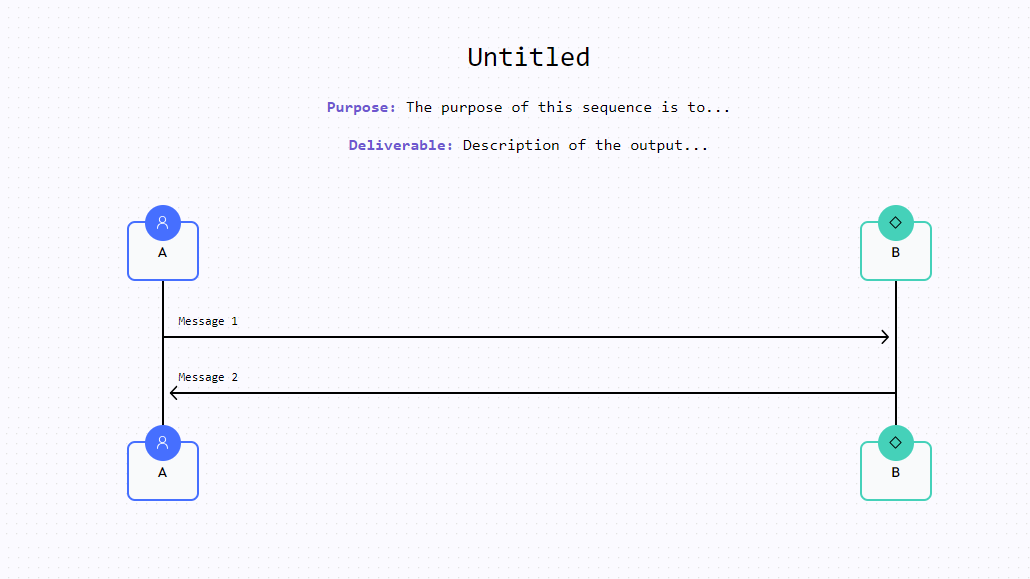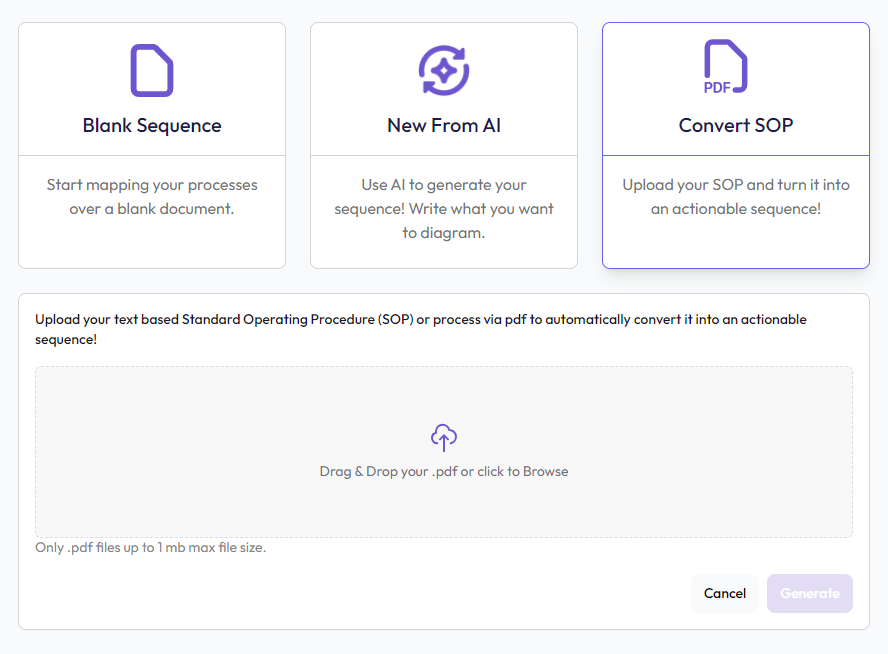Sequence Types
Choosing a Sequence type
Sequences are the core of SequenceStack. Creating and using a sequence allows access to a great deal of benefits through laying out the steps and intricacies involved in the daily proccesses used by a company. SequenceStack offers a variety of methods to create a sequence tailored to any needs.
There are many ways to create a sequence using SequenceStack, each one having their own benefits and differences. This page will lay out the proccesses involved in the creation of each type of sequence and the reasons to choose each option.
To create a sequence, from the dashboard, click on the "New Sequence" button in the top left of the screen. This button will take you to the new sequence page, where you can select from one of the sequence creation options to begin creating your sequence.
NewSequenceButton-422906deb29d52b98171b9a4edfca394.png)
Creating a blank Sequence
The primary method of creating a sequence is to create one from scratch. This method of sequence creation will generate a sequence template with the bare minimum needed to have a functional sequence. This basic template will lay out some of the usable syntax needed to create a sequence. Using this simple template makes it easy to quickly start a sequence with a plan already in mind, as it requires simple replacement of existing keywords to your own desired sequence parameters.
This method is a simple and easy way to start any sequence, allowing strong control over the core structure and making it easy to expand the sequence to be more complicated and in depth if need be.
The template should look like this when selecting a blank sequence.

Once this new sequence has been created, and the template is ready, all that is needed to continue working and developing the sequence is to replace some of the template values with your own. Replacing the title with your desired title, and replacing the actors and messages with ones that suit the desired sequence. This will allow you to easily get started with a simple basic sequence to develop on and expand, rather than having to start completely from scratch.
At any time during the editing of a sequence, you can click on the "Full Example" button to find a quick display of the various styles that can be used to create a sequence.
Creating an AI Sequence
When creating a sequence, it can be very helpful to be able to have a template or base to start from. Creating a blank sequence and setting up a sequence from stratch can take time, especially when needing to make many sequences. Using our AI tool to generate sequences can make creating a sequence simpler and easier.
When creating a new sequence, there will be 3 options to select from. A blank sequence, an AI sequence, and an SOP sequence. Selecting a blank sequence will create the blank template to begin working from immediately. This is the manual and more finely controlled method of creating sequences. An AI sequence, on the other hand, is faster and will generate a sequence for you immediately. To create an AI sequence, begin by filling out the provided form.

AI Sequence Requirements
To create an AI sequence, the AI needs to know the desired sequence to generate it. In the form, there are a few sections. When clicking on a section, it should contain tips on how to inform the AI best. Every sequence should have a few parameters to inform it of what the sequence should be. A sequence should have:
- A Scenario - What is the sequence about?
- A Format - How should the sequence be presented?
- An Owner - Who will evaluate the sequence?
- A team - Should this sequence be shared with a SequenceStack team?
An example of a sequence that meets these requirements might be: "I am the CEO of BabyFood Inc. (Owner) I want a sequence that I can use to determine if our reportings for quarterly earnings are 100% accurate. We get our reports from the accounting department, who investigates all branches of the company to determine income and costs. (Scenario). This sequence should be 20 steps or less, and should include 3 departments as an example: Marketing, Manufacturing, and Transport. The sequence should detail how the accounting department investigates these branches (Format)".
This prompt will inform the AI of how to contruct your sequence and the rules it should follow. Of course, the more detailed the prompt provided to the AI, the more accurate the generated sequence will be to the desired outcome. More detail leads to better accuracy, but for quick and dirty sequence generation, a short and simple prompt will also work. Even with little detail in the prompt, an AI sequence is still very helpful for coming up with a baseline sequence to work from, speeding up sequence creation greatly, and avoiding any "Blank canvas" writing blocks.
In the AI form, the sequence to be created may also be shared with an existing SequenceStack team. By selecting a team from this menu, it will be automatically shared upon the generation of that sequence. This makes jump-starting work on a sequence with a team even faster and easier.
SOP Sequence Generation
Another option for a new sequence is the "Convert SOP" AI sequence. This option is very similar to the generic AI sequence, however the steps are different and much simpler to use. Creating an SOP (Standard Operating Procedure) sequence requires a user to submit a PDF version of the SOP document being used. This file must be less than 1 mb.
The SOP generation uses this PDF file to scan it and convert it into input for generating an AI sequence. This option is able to create a highly accurate and detailed sequence with far less manual input than a traditional AI sequence, allowing for faster results and greater utility from the more accurate input. Due to the quantity of information it will take longer than a traditional AI sequence, but will generate far higher quality results.


SequenceEditor-0ffc6c1029eaded4e47a2a1565e9470f.PNG)